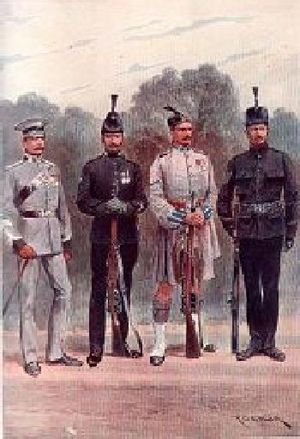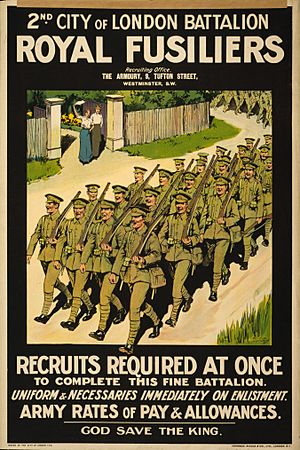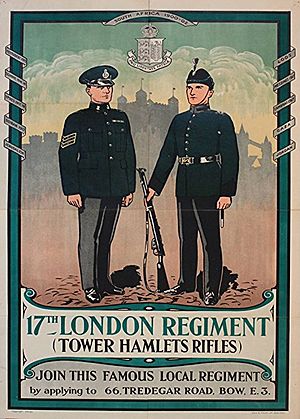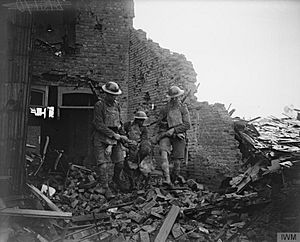London Regiment (1908–1938) facts for kids
Quick facts for kids London Regiment |
|
|---|---|
| Active | 1908–1938 |
| Allegiance | |
| Branch | |
| Type | Infantry |
| Role | Territorial Force / Territorial Army |
The London Regiment was a group of infantry soldiers in the British Army. It was part of the Territorial Force, which later became the Territorial Army. This regiment fought in the First World War. It was officially closed down in 1938, just before the Second World War. Many of its groups of soldiers (called battalions) were then changed into other types of units. The regiment was formed again in 1993. Today, the London Guards trace their history back to this regiment, which started in 1908.
Contents
History of the London Regiment
How the Regiment Began in 1908
The London Regiment was first created in 1908. It brought together 26 groups of volunteer soldiers, called battalions, from the new County of London. Each battalion had its own special uniform. These London battalions were part of the London District. This district mainly included the 1st and 2nd London Divisions.
The London Regiment in the First World War
When the First World War began, the London Regiment grew much larger. It expanded to include 88 battalions. Many of these battalions saw action in different parts of the world.
Battles and Fronts
- 49 battalions fought in the trenches on the Western Front in France and Flanders.
- Six battalions fought in the Gallipoli Campaign.
- 12 battalions fought at Salonika.
- 14 battalions fought against the Turks in Palestine.
- One battalion fought in Waziristan and Afghanistan.
New Battalions and Home Service
Soon after the war started, new "Reserve" or "2nd-Line" units were created. These were backup units for the existing Territorial Force units. They were called things like '2/1st London Battalion'. At first, these units were made of soldiers who had not volunteered to fight overseas. They also included many new recruits.
Later, these 2nd-Line units were sent overseas to fight. Then, new "3rd-Line" units were formed. Their job was to train and supply new soldiers for the fighting battalions. Some battalions, like the 1st, 2nd, 3rd, and 4th London Battalions, even sent three battalions overseas. They also formed 4th-Line reserve units. This is how the 26 battalions before the war grew to 82 battalions.
In June 1915, soldiers in the Territorial Force who had only signed up for service in Britain were put into special "Provisional Battalions." These units helped defend the coast. By 1916, new laws meant that all men could be called up for overseas service. The provisional battalions then had two jobs: defending Britain and getting men fit to be sent to fight abroad.
After the Wars: Changes and Reformation
The London Regiment was reformed in the Territorial Army in the 1920s. In 1924, its individual battalions were given special awards called "battle honours" for their bravery.
However, the regiment officially stopped existing in 1938. All its battalions were then moved to other regular infantry regiments. Some joined the Royal Artillery or the Royal Engineers. For example, the 5th Battalion became the 1st Battalion, London Rifle Brigade, which was part of The Rifle Brigade (Prince Consort's Own).
The London Regiment was formed again in 1993. This happened by bringing together some of the groups that had once been part of the original regiment. In 2021, it was announced that the London Regiment would be renamed the 1st Battalion London Guards by February 2024.
See also
Sources
- Becke, Major A.F., (2007) History of the Great War: Order of Battle of Divisions, Part 2b: The 2nd-Line Territorial Force Divisions (57th–69th), with the Home-Service Divisions (71st–73rd) and 74th and 75th Divisions, London: HM Stationery Office, 1937/Uckfield: Naval & Military Press, ISBN: 1-847347-39-8.
- Becke, Major A.F., (2007) History of the Great War: Order of Battle of Divisions, Part 3a: New Army Divisions (9–26), London: HM Stationery Office, 1938/Uckfield: Naval & Military Press, ISBN: 1-847347-41-X.
- Grey, Major W.E., (2002) 2nd City of London Regiment (Royal Fusiliers) in the Great War 1914–19, Westminster: Regimental Headquarters, 1929/Uckfield: Naval & Military Press, ISBN: 978-1-843423-69-0
- Grimwade, Captain F. Clive, (2002) The War History of the 4th Battalion The London Regiment (Royal Fusiliers) 1914–1919, London: Regimental Headquarters, 1922/Uckfield, Naval & Military Press, ISBN: 978-1-843423-63-8.





